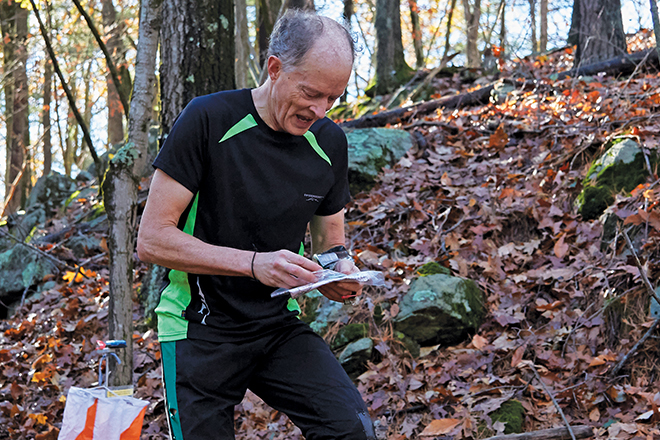Article by Tim Parsons, retired; formerly of Beaver Country Day School
What is competitive orienteering? Simply put: running alone through the woods, looking at a map and occasionally reading a compass to find a series of checkpoints in the fastest time possible.
I got into orienteering in 1985 when a roommate told me there was a sport that involved maps and running, two of my favorite things. I tried it, and I loved it. Previously I’d done rowing and long-distance running, sports in which you work so hard you can barely think. What I like about orienteering is the combination of mental and physical challenge: You’re pushing yourself hard aerobically, but you still need to maintain the ability to think carefully about where you’re going and how you’ll get there.
A big part of the battle now, as joints wear out and eyesight blurs, is who can age the slowest.
At an orienteering race, you’re given a specialized map marked with a number of points to which you must navigate, in order. Orienteering maps are custom-made and highly detailed, down to the level of individual boulders. You carry an electronic chip, which you put into each checkpoint box, and it beeps as it registers you. A great thing about the technology is that afterwards you can see how you performed on every leg of the race, compared to everyone else on the same course. Results are broken into age brackets. I’ve been racing against the same group of guys across the U.S. for the past 30+ years. A big part of the battle now, as joints wear out and eyesight blurs, is who can age the slowest.
People often ask if we use GPS while orienteering. It’s not allowed in serious competitions, but even if it were, it wouldn’t help the good competitors; it doesn’t provide enough precision and would slow down decision-making. For equipment, I use an old-fashioned baseplate compass, marked with a rough pace-to-distance scale along one edge. My well-worn apparel includes gaiters and shoes with steel-studded cleats.
Ticks and thorns are common “side benefits.” When I roll up my sleeves at work during orienteering season, I’ll often get questions about all the scratches.
Each race is an adventure, even if it’s at a local state park I’ve been in many times before — that day’s course might take me to parts of it I’d never seen. Once my time has started, I take a few seconds to decide my strategy for the first checkpoint, then start running, fine-tuning my route choice as I go. Often there’s a trade-off between a shorter route with more chance of getting lost, and a longer, safer route. I usually set a rough compass bearing, but the navigation is primarily by reading terrain details like boulders and contours as I go along. I’m constantly evaluating how certain I am of my location, and try to adjust quickly if things don’t go as planned. There’s always a small sense of relief when I see the marker flag that I’m looking for — then it’s on to the next.
Beyond the intellectual challenge, physically it’s a chance to be like a kid again. I’ll jump off (little) cliffs, hop across streams, wade through swamps and slide down mud banks. Ticks and thorns are common “side benefits.” When I roll up my sleeves at work during orienteering season, I’ll often get questions about all the scratches.
After I had children, a son and daughter, I got them into it. It’s a great family activity, and wonderful to see them learning. My daughter made the junior national team several years ago, and we’ve raced together abroad. My wife tried it once, got a bad case of poison ivy, and swore it off forever.
Orienteering events have taken me to many beautiful parts of the U.S., Canada and Europe. Some of my favorite places to race are the Hudson Valley in New York, the rolling hills of Northern California and the Dolomite mountains in Italy. I’ve been lucky to live near Boston, which has a strong orienteering scene. Now that I've retired and moved to Maine, I’ll have plenty of trails to train on, but there won’t be many races nearby. Still, I hope to get to regional, national and international meets when I can — I’d like to keep orienteering for many more years.



